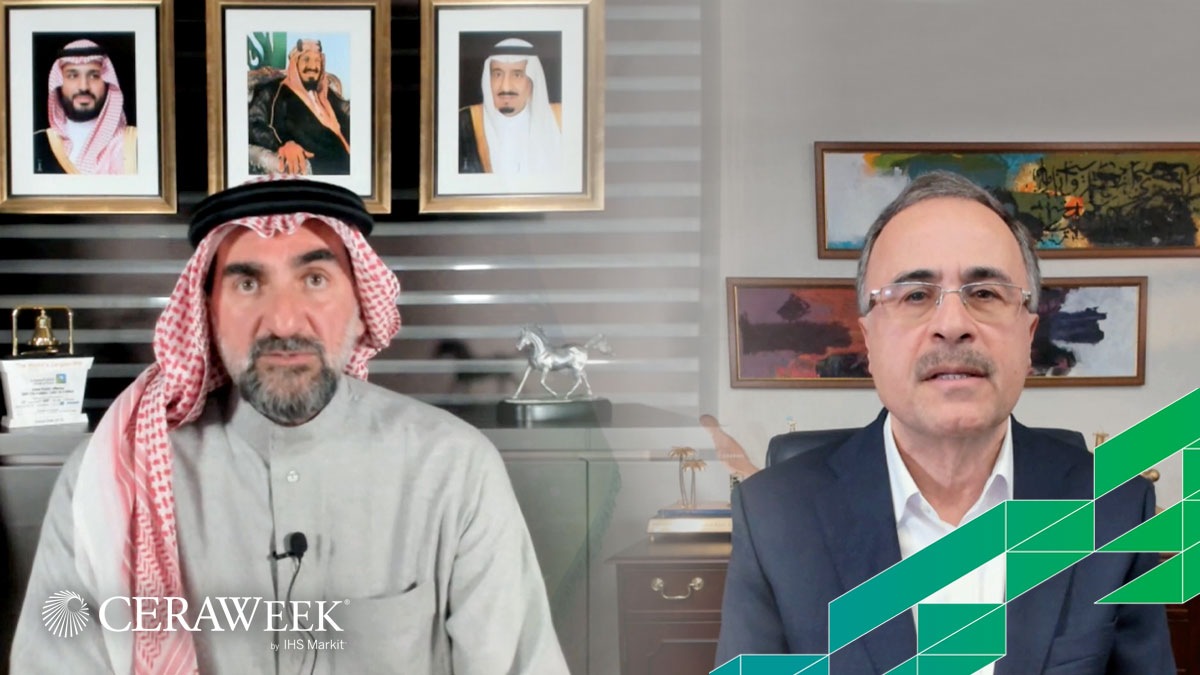CERA WEEK
Aramco leadership share new economic map at CERAWeek
The video is blocked
Global March 03, 2021 - By
Al-Rumayyan and Nasser share thoughts at major industry event.
Aramco’s top executives discussed economic and industry trends as well as energy transition, at one of the world’s premier energy conferences, CERAWeek 2021.
The digital edition of the conference follows an extraordinarily difficult year in 2020, in which the global COVID-19 pandemic exerted profound impacts on the global economy and on the energy industry. Yet 2020 was also a year in which Aramco made a number of achievements, completing the acquisition of a 70% stake in SABIC, reaching a historic peak in single day crude oil production, and continuing to deliver the energy the world needs reliably and safely.
HE Yasir O. Al-Rumayyan, chairman of the Board of Saudi Aramco, and Amin Nasser, president and CEO of Saudi Aramco, participated in the conference, which is being held this week, March 1-5. Other participants included senior executives, government officials, thought leaders, academics, technology innovators, and financial leaders.
More appetite for investment
In a question and answer session with IHS Markit vice chairman and CERAWeek chairman, Daniel Yergin, Al-Rumayyan said that Aramco’s IPO in 2019 may be just the beginning of the company’s entry into global markets as a publicly traded company.
“The IPO of Saudi Aramco in 2019 was the largest, and I think, still is the largest of IPOs in history,” Al-Rumayyan said. “I think once we see the economic conditions improving, once we see more appetite for investment from institutions and investors, we may consider selling more shares of Aramco. It is for the government of Saudi Arabia to decide that.”
The conference comes at a time of dramatic change for the global economy, and for the energy industry’s place as a driver of growth. Advanced technologies, new and emerging industries, shifting consumption patterns, and a growing demand for low carbon solutions are all changing the landscape in which energy leaders must make decisions. The COVID-19 pandemic only sharpened these issues, as they forced industry leaders to adapt and innovate to keep the world’s economic engines running.
In a virtual panel session with Mike Wirth, chairman and CEO of Chevron, moderated by Yergin, Nasser said the COVID-19 pandemic had exposed some “harsh realities for the world,” but that it had also “sharpened our focus on resilience, which gave us the agility to respond quickly to volatile markets.”
“We were faced with one of the biggest crisis in a century, but our industry is used to challenging situations,” Nasser said.
COVID-19 has made businesses improve their ways of doing business, Nasser added. “COVID-19 also accelerated our plans to digitalize operations in deploying and utilizing artificial intelligence, industrial Internet of Things, and big data.”
Fortunately, technological innovation is one of Aramco’s strong suits. In the past year, for instance, Aramco’s Khurais plant joined ‘Uthmaniyah as a Lighthouse of innovation for its implementation of Fourth Industrial Revolution technologies, such as intelligent field sensors, machine learning, and remote inspection robots. In addition, the company has implemented other groundbreaking technologies, such as digital helmets for inspectors, which allows real-time reporting from on the ground inspectors, while avoiding the risk of exposure that a larger inspection team might require.

Cause for optimism
On the economic front, while Nasser worries about the prospects of a jobless recovery, he sees signs of economic expansion, with growing demand for oil in China, East Asia, and India in particular. The economies of Europe and the U.S. are slower to recover, Nasser added, although the rapid deployment of vaccines is cause for optimism.
“After last year’s drop in oil demand there are positive signs now that the market is improving,” Nasser said.
Aramco has followed through on and will continue to follow through on its efforts to develop cleaner energy solutions that help to reduce carbon emissions, Nasser said, including increasing the production of natural gas as a cleaner fuel source for domestic and international energy markets. Aramco will see a “huge potential” for the development of hydrogen as a fuel source, Nasser said. With its groundbreaking deliveries of blue ammonia to Japan last September, Aramco has taken its carbon reduction stand to new levels, he added.
Achievements in clean fuels are just one example of the way in which Aramco takes its role as a global industry leader seriously. Its Environmental, Social, and Corporate Governance (ESG) policies are designed to have positive impacts both globally and in the communities where we operate.
“ESG is a big part of Aramco’s corporate strategy,” Nasser said. “Our focus has always been on the stakeholders’ interest.
“We are all for ESG, but a one-size-fits-all ESG framework or too many of them won’t work. It must be stakeholders focused and more importantly, be inclusive,” Nasser added. “For example, our customer base is global, but almost three-quarters of our customers are in emerging markets, and this is why a balance is needed in developing a common framework.”
This year’s CERAWeek sessions and themes were inspired by Yergin’s new book “The New Map: Energy, Climate, and the Clash of Nations.”



